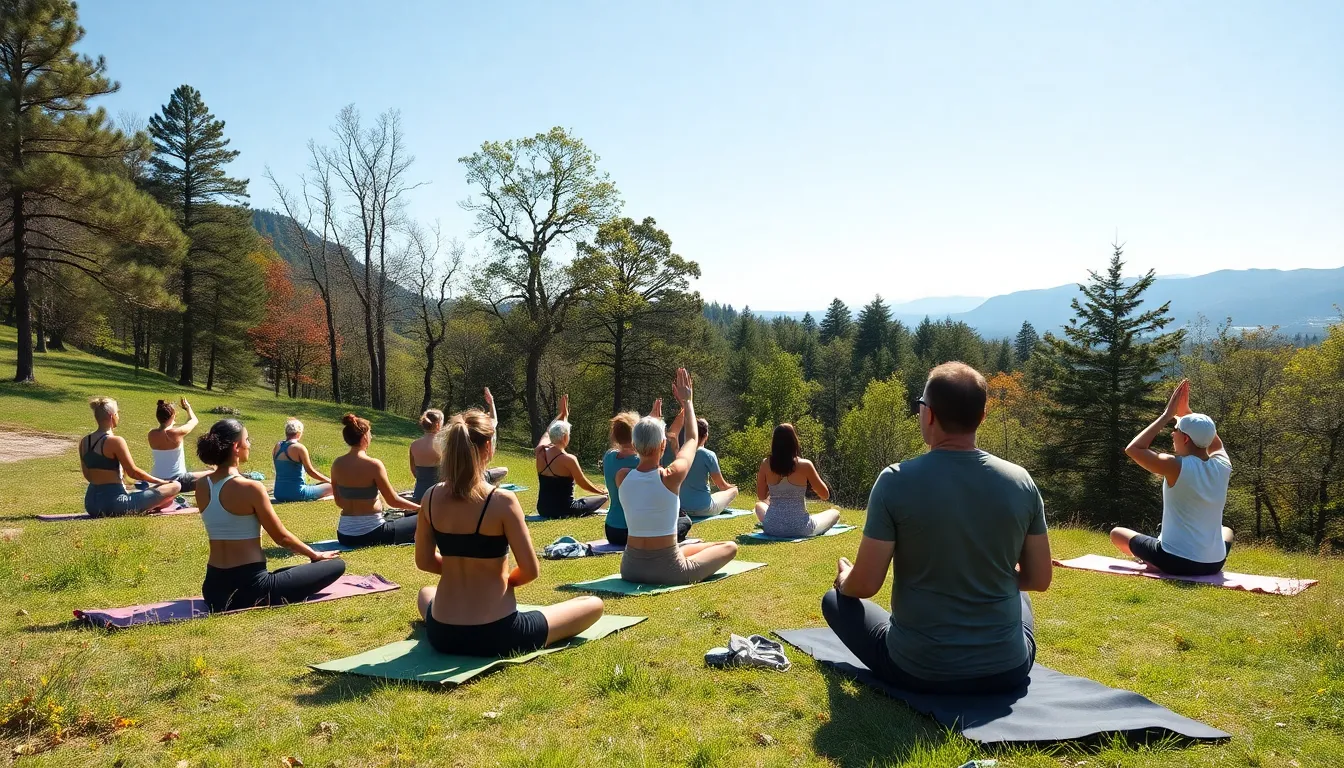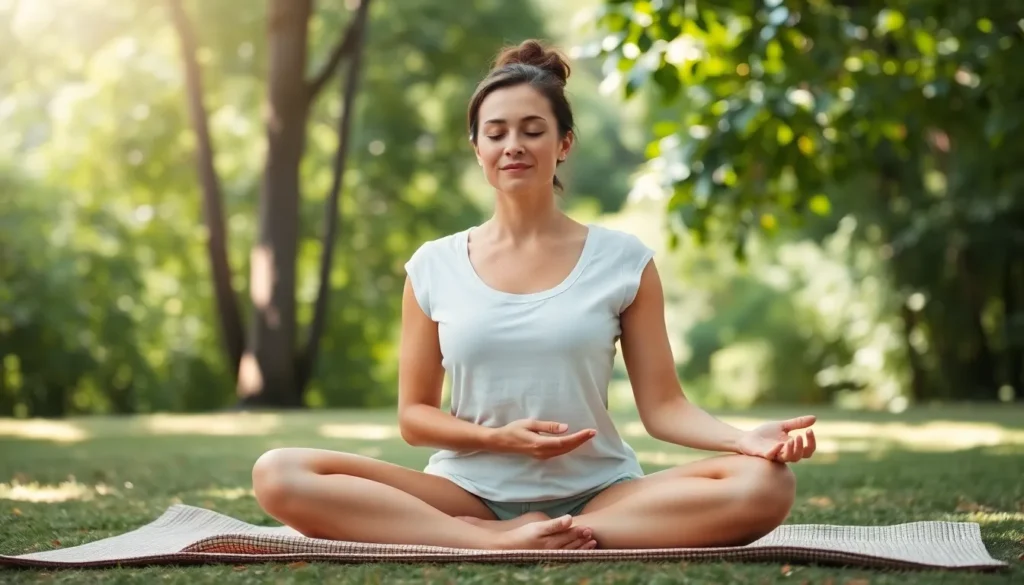In a world buzzing with distractions and endless to-do lists, finding a moment of peace can feel like searching for a needle in a haystack. Enter mindfulness-based practices, the superhero of stress relief. These techniques don’t require a cape or superpowers—just a willingness to breathe, focus, and maybe sit cross-legged for a bit.
Imagine transforming chaos into calm with just a few minutes of your day. Mindfulness isn’t just for yogis or meditation gurus; it’s for anyone who’s ever felt overwhelmed by life’s demands. Whether it’s through meditation, mindful eating, or simply taking a moment to appreciate your coffee, these practices can help anyone reclaim their sanity. So why not dive in and discover how a little awareness can go a long way in making life a lot more enjoyable?
Table of Contents
ToggleOverview of Mindfulness Based Practices
Mindfulness-based practices encompass various techniques aimed at fostering awareness and presence in daily life. These techniques promote focus on the current moment, reducing stress and enhancing overall well-being. Meditation serves as a cornerstone of mindfulness, inviting individuals to engage in focused breathing and visualization.
Mindful eating encourages individuals to savor each bite and appreciate the flavors, making mealtimes a form of meditation. Yoga integrates movement with breath, creating a holistic approach that nurtures both body and mind. These practices are not limited to specific groups; anyone can access them regardless of experience level.
Breathwork synthesizes deep, intentional breathing patterns with mindfulness, promoting relaxation and grounding. Body scans represent another technique, guiding attention through different body parts to cultivate awareness of bodily sensations.
Journaling can also complement mindfulness, allowing individuals to process thoughts and emotions as a form of reflective practice. Research highlights the benefits of incorporating mindfulness into lifestyle habits, significantly impacting mental health and emotional resilience.
Daily life offers myriad opportunities to practice mindfulness, from walking in nature to routine tasks. Over time, regular engagement with these practices enhances one’s ability to respond calmly to stressors. Incorporating a blend of these techniques leads to greater emotional regulation and a more peaceful existence.
Benefits of Mindfulness Based Practices

Mindfulness-based practices offer a multitude of benefits that contribute to overall well-being. These practices not only enhance mental health but also promote physical health.
Mental Health Benefits
Increased awareness leads to improved emotional regulation. Practicing mindfulness helps reduce symptoms of anxiety and depression. Regular meditation fosters greater self-compassion, aiding individuals in coping with stress. Enhanced focus emerges as practitioners learn to concentrate on the present moment. Studies indicate that individuals engaged in mindfulness report heightened levels of life satisfaction. Integration of mindfulness techniques in daily routines yields long-term mental health benefits.
Physical Health Benefits
Mindfulness contributes to improved physical health through stress reduction. Reduced stress levels lower the risk of chronic conditions, such as heart disease and hypertension. Engaging in mindful eating promotes healthier dietary habits that lead to weight management. Lowered cortisol levels enhance immune system function, supporting overall health. Regular practice encourages better sleep quality, allowing for more restorative rest. Enhanced body awareness helps individuals notice physical discomfort, leading to timely medical attention when necessary.
Common Mindfulness Based Practices
Mindfulness-based practices enhance awareness and presence in daily life. Several techniques promote relaxation and emotional processing, proving effective for stress relief.
Meditation Techniques
Meditation techniques focus on various methods to enhance mindfulness. Breathing exercises encourage attention on inhaling and exhaling, helping cultivate a calm mind. Visualization practices guide individuals through imagery to promote relaxation. Some methods incorporate mantra repetition, aiding concentration and reducing distractions. Each technique offers unique benefits, contributing to improved emotional regulation and mental clarity.
Mindful Breathing
Mindful breathing emphasizes the importance of breath in achieving mindfulness. Practitioners concentrate on their breath’s rhythm, fostering a state of focus. Deep, slow breaths promote relaxation and decrease stress levels. It’s common to pair mindful breathing with visualization to enhance its effects. Regular practice leads to greater awareness and a more centered mental state.
Body Scan
Body scan techniques facilitate deep relaxation through focused awareness. Participants lie comfortably and direct attention to different body areas. This process promotes heightened awareness of physical sensations and helps release tension. Scanning from head to toe allows individuals to discover areas needing attention. Incorporating body scans into daily routines supports relaxation and emotional processing.
Implementing Mindfulness Based Practices in Daily Life
Implementing mindfulness into daily routines enhances overall well-being. Mindfulness can be seamlessly integrated, making it accessible for everyone.
Tips for Beginners
Start small by dedicating just a few minutes each day to mindfulness activities. Selecting a quiet space aids in focusing attention. Breathing exercises serve as an excellent introduction, cultivating awareness and reducing stress. Engaging in mindful eating can transform meals into peaceful experiences, encouraging intentionality. Practicing gratitude journaling offers a way to process emotions and reflect positively. Establishing a consistent time each day fosters habit formation. Utilizing mindfulness apps can provide guidance and support, ensuring effective practice.
Creating a Mindful Environment
Designing a mindful environment promotes relaxation and focus. Decluttering spaces reduces distractions and enhances serenity. Incorporating natural elements, such as plants and soft lighting, helps foster a calming atmosphere. Playing gentle sounds or music can support relaxation and mindfulness practices. Choosing a designated area for meditation or yoga encourages consistency and commitment. Keeping distractions away during practice maximizes effectiveness. Personalizing the space with inspirational quotes or images can deepen engagement and enhance mindfulness experiences.
Mindfulness-based practices offer a transformative approach to navigating the complexities of modern life. By fostering awareness and presence, these techniques empower individuals to reclaim their peace amidst chaos. Whether through meditation, mindful eating, or yoga, everyone can find a practice that resonates with them.
The benefits extend beyond mental health to physical well-being, promoting a healthier lifestyle and emotional resilience. As individuals integrate mindfulness into their daily routines, they unlock the potential for greater life satisfaction and overall wellness. Embracing these practices can lead to a more fulfilling and balanced existence, encouraging a deeper connection to oneself and the world.

